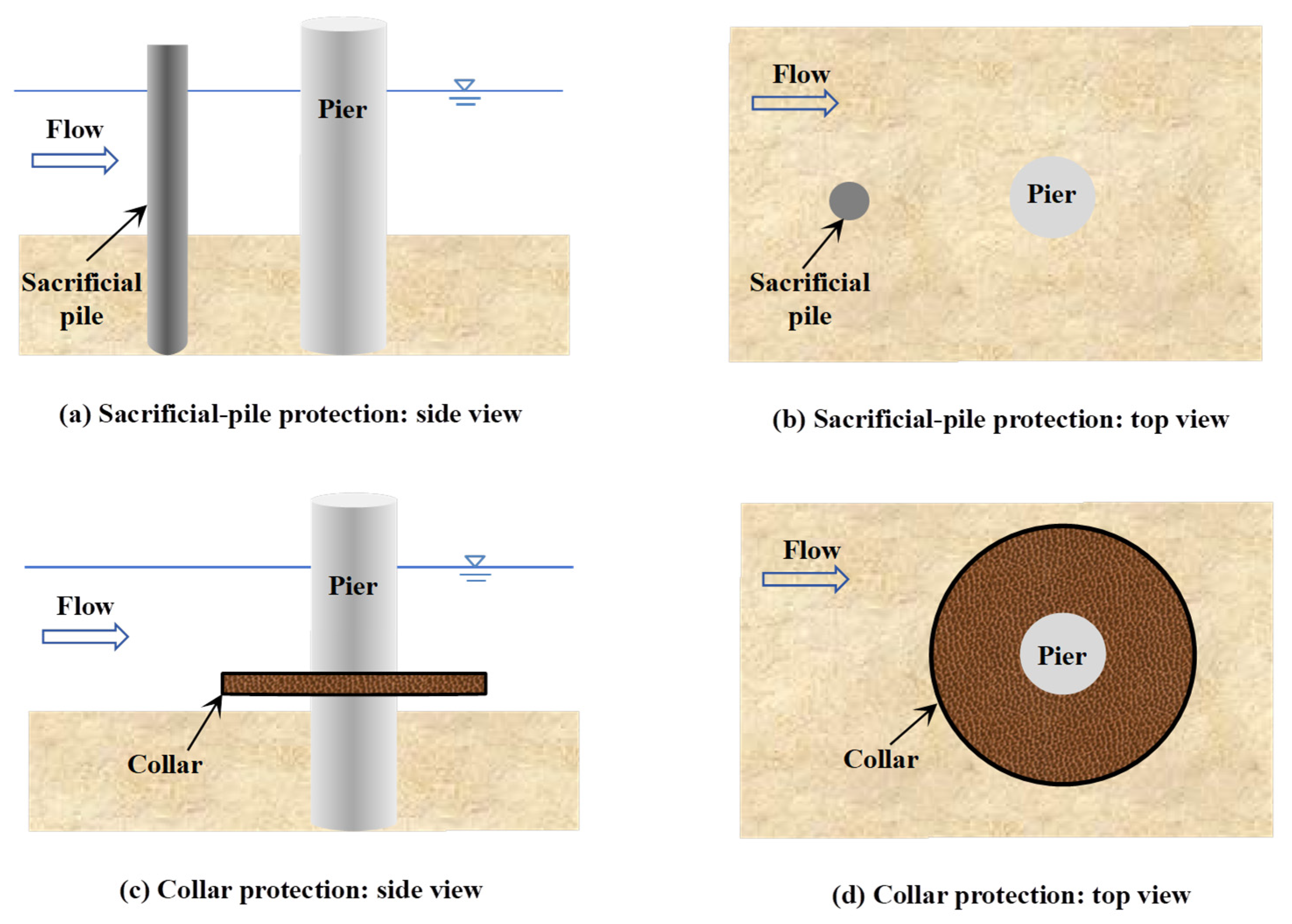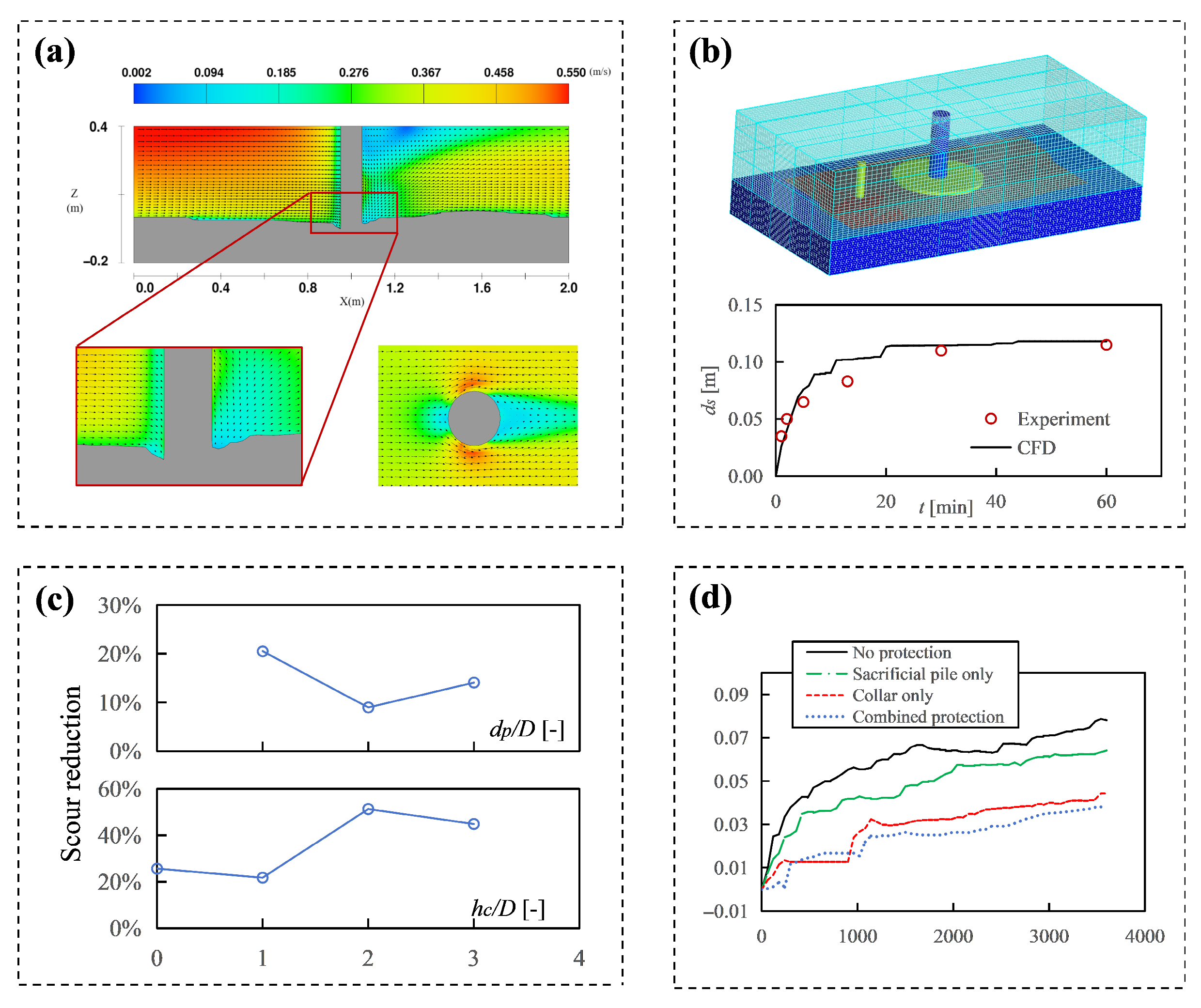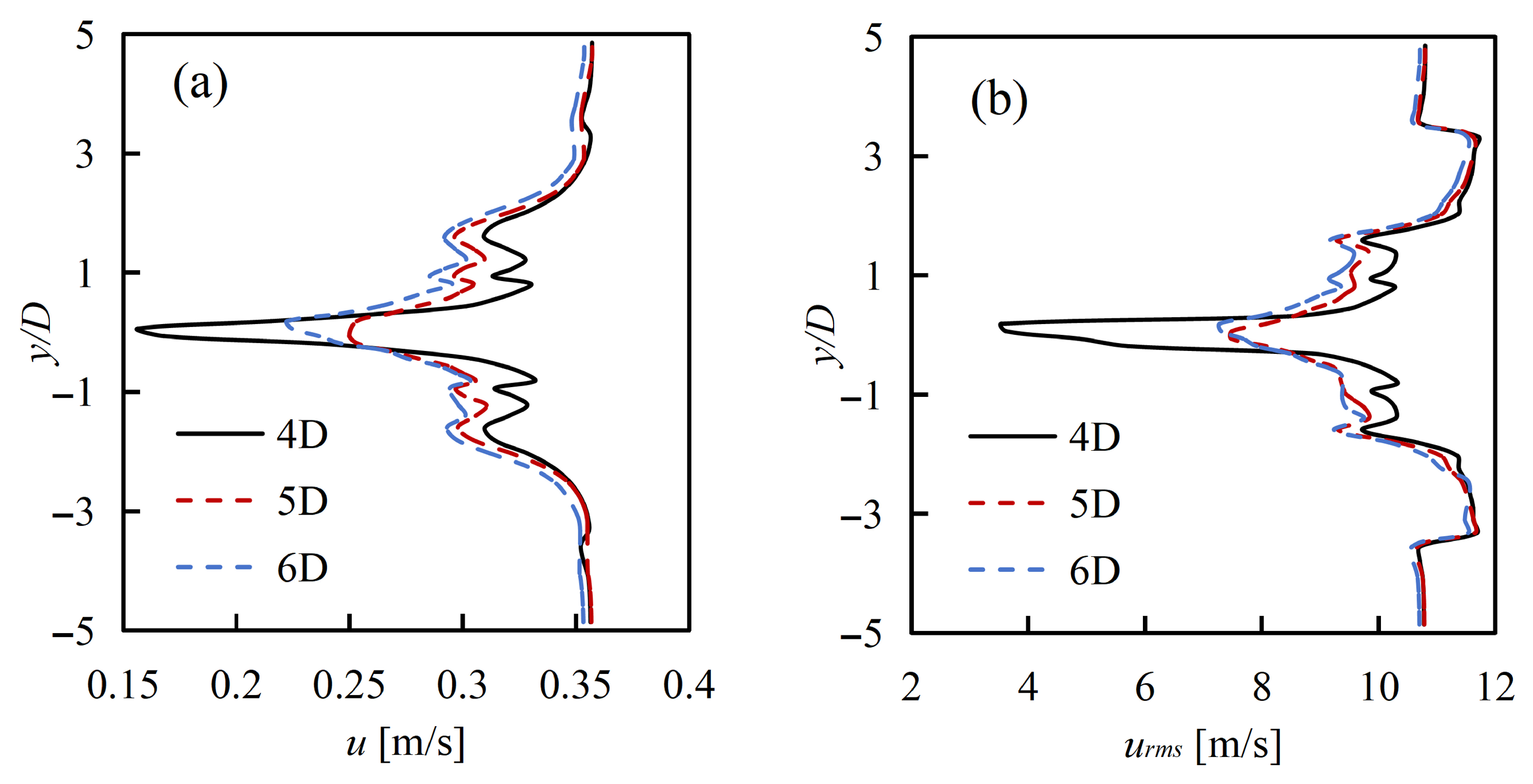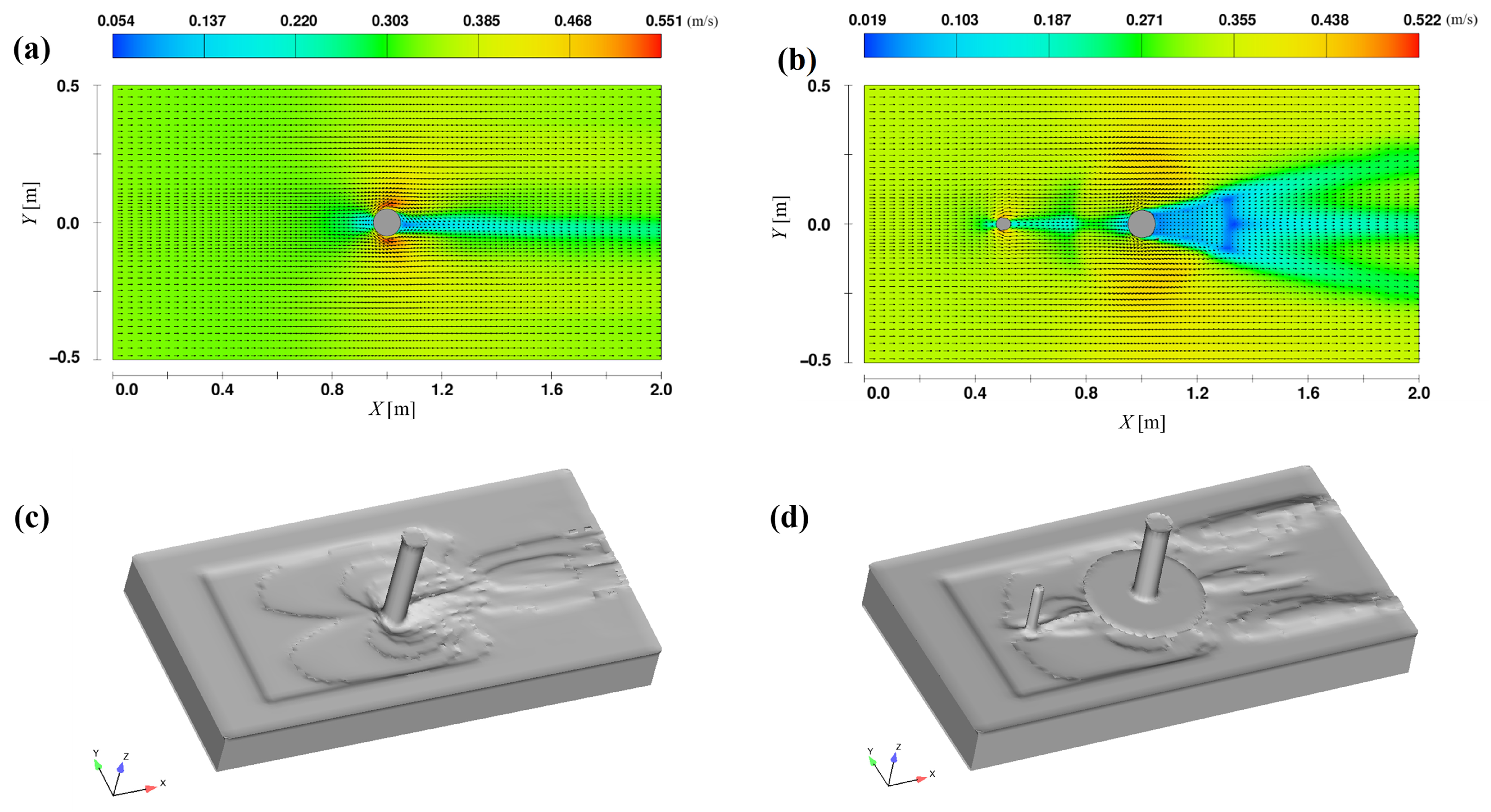Optimization of Combined Scour Protection for Bridge Piers Using Computational Fluid Dynamics
Abstract
1. Introduction
2. Mathematical and Numerical Framework
2.1. Governing Hydrodynamic Equations
2.2. Sediment Transport and Morphodynamics
3. Model Validation
3.1. Numerical Setup
3.2. Validation of Flow
3.3. Validation of Scour
4. Combined Scour Protection
4.1. Scour Without Protection
4.2. Effect of Sacrificial-Pile Distance
4.3. Effect of Collar Height
4.4. Optimal Configuration
4.5. Discussion of Applicable Conditions
- (i)
- Unsteady hydrographs: Rapidly rising or falling flood events can produce deeper but shorter-lived scour holes; synthetic hydrograph-coupled CFD can be used for pre-screening, but must ultimately be validated with scaled physical tests.
- (ii)
- Pier groups: Wake-wake interactions between closely spaced piers may amplify local scour; preliminary CFD suggests that the optimal pile-to-pier spacing shifts and the collar diameter should be enlarged when pier spacing is reduced.
- (iii)
- Coarse or broadly graded sediment: Armoring and hiding-exposure effects in non-uniform beds may reduce scour depths; a two-layer sediment transport model is recommended for screening-level analyses.
- (iv)
- Ice and debris loading: Collars can act as debris collectors, increasing drag and potentially altering flow patterns; removable collar sections and regular post-flood inspections are advised.
- (v)
- Construction and maintenance: GPS-guided installation and pre-construction bathymetric surveys help keep alignment errors within the narrow tolerance band that preserves SPC efficiency; periodic checks for pile tilt and collar settlement are recommended.
5. Conclusions
- (1)
- A verified CFD model, benchmarked against laboratory flow and scour data, replicates scour depths within error of 3%, thus providing a robust numerical platform for evaluating countermeasures.
- (2)
- Deployment of the combined sacrificial-pile and collar (SPC) system fundamentally altered the local scour pattern, which shows that the upstream conical pit is almost eliminated, and lateral scour becomes wider yet markedly shallower.
- (3)
- Parametric optimization shows that scour mitigation is maximized when the pile is located at dp/D = 5 ahead of the pier and the collar is elevated hc/D = 0.2 above the bed, yielding a 51% reduction in maximum scour depth compared to the unprotected case.
- (4)
- The combined system outperformed the sum of individual pile (18%) and collar (41%) efficiencies, demonstrating a synergistic interaction that suppresses the horseshoe vortex and redistributes bed shear stress without inducing secondary erosion.
Author Contributions
Funding
Data Availability Statement
Conflicts of Interest
References
- Xiong, W.; Cai, C.S.; Zhang, R.; Shi, H.; Xu, C. Review of hydraulic bridge failures: Historical statistic analysis, failure modes, and prediction methods. J. Bridge Eng. 2023, 28, 03123001. [Google Scholar] [CrossRef]
- Ettema, R.; Gonstantinescu, G.; Melville, B.W. Flow-field complexity and design estimation of pier-scour depth: Sixty years since Laursen and Toch. J. Hydraul. Eng. 2017, 143, 03117006. [Google Scholar]
- Wang, C.; Yu, X.; Liang, F.Y. A review of bridge scour: Mechanism, estimation, monitoring and countermeasures. Nat. Hazards 2017, 87, 1881–1906. [Google Scholar] [CrossRef]
- Li, J.Z.; Qi, M.L.; Fuhrman, D.R.; Chen, Q.G. Influence of turbulent horseshoe vortex and associated bed shear stress on sediment transport in front of a cylinder. Exp. Therm. Fluid Sci. 2018, 97, 444–457. [Google Scholar] [CrossRef]
- Li, J.; Yang, Y.; Yang, Z. Influence of scour development on turbulent flow field in front of a bridge pier. Water 2020, 12, 2370. [Google Scholar] [CrossRef]
- Yang, Y.L.; Qi, M.L.; Li, J.Z. Evolution of hydrodynamic characteristics with scour hole developing around a pile group. Water 2018, 10, 1632. [Google Scholar] [CrossRef]
- Yang, Y.L.; Li, J.Z. Experimental study of flow field around pile groups using PIV. Exp. Therm. Fluid Sci. 2021, 120, 110223. [Google Scholar] [CrossRef]
- Yang, Y.L.; Qi, M.L.; Wang, X.; Li, J.Z. Experimental study of scour around pile groups in steady flows. Ocean. Eng. 2020, 195, 106651. [Google Scholar] [CrossRef]
- Qi, M.L.; Li, J.Z.; Chen, Q.G. Comparison of existing equations for local scour at bridge piers: Parameter influence and validation. Nat. Hazards 2016, 82, 2089–2105. [Google Scholar] [CrossRef]
- Qi, M.L.; Li, J.Z.; Chen, Q.G. Applicability analysis of pier-scour equations in the field: Error analysis by rationalizing measurement data. J. Hydraul. Eng. 2018, 144, 04018050. [Google Scholar] [CrossRef]
- Chiew, Y.M. Scour protection at bridge piers. J. Hydraul. Eng. 1992, 118, 1260–1269. [Google Scholar] [CrossRef]
- Chen, J.; Qu, Y.; Sun, Z. Protection mechanisms, countermeasures, assessments and prospects of local scour for cross-sea bridge foundation: A review. Ocean Eng. 2023, 288, 116145. [Google Scholar] [CrossRef]
- Cui, J.; Bao, T.; Ding, X.; Tang, C.; Li, T.; Zhou, W. Scour prediction, monitoring, and protection measures for offshore wind turbines: Recent advancements and insights. Ocean Eng. 2025, 339, 122194. [Google Scholar] [CrossRef]
- Melville, B.W.; Hadfield, A.C. Use of sacrificial piles as pier scour countermeasures. J. Hydraul. Eng. 1999, 125, 1221–1224. [Google Scholar] [CrossRef]
- Wang, S.; Wei, K.; Shen, Z.; Xiang, Q. Experimental investigation of local scour protection for cylindrical bridge piers using anti-scour collars. Water 2019, 11, 1515. [Google Scholar] [CrossRef]
- Lee, W.L.; Lu, C.W.; Huang, C.K. Application of a single porous basket as a pier scour countermeasure. Water 2021, 13, 3052. [Google Scholar] [CrossRef]
- Shahhosseini, M.; Yue, S.; Xu, J.; Zhang, M.; Yu, G. Scour depth at a pile with a collar at bed level in clear-water current. Ocean Eng. 2025, 320, 120319. [Google Scholar] [CrossRef]
- Chiew, Y.M.; Lim, F.H. Parametric study of riprap failure around bridge piers. J. Hydraul. Res. 2001, 39, 61–72. [Google Scholar] [CrossRef]
- Dey, S.; Sumer, B.M.; Fredsoe, J. Control of scour at vertical circular piles under waves and current. J. Hydraul. Eng. 2006, 132, 270–279. [Google Scholar] [CrossRef]
- Qi, L.; Li, N.; Zhu, K.; Sun, Z.; Wang, Z.; Yang, J.; Wang, J. Numerical simulation study on the protective performance of scour protection ring for offshore wind turbine single pile foundation. Coast. Eng. 2024, 43, 129–141. [Google Scholar]
- Farooq, R.; Ghumman, A.R.; Tariq, M.A.U.R.; Ahmed, A.; Jadoon, K.Z. Optimal octagonal hooked collar countermeasure to reduce scour around a single bridge pier. Period. Polytech. Civ. Eng. 2020, 64, 1026–1037. [Google Scholar] [CrossRef]
- Farooq, R.; Azimi, A.H.; Tariq, M.A.U.R.; Ahmed, A. Effects of hooked-collar on the local scour around a lenticular bridge pier. Int. J. Sediment Res. 2023, 38, 1–11. [Google Scholar] [CrossRef]
- Keshavarz, A.; Vaghefi, M.; Ahmadi, G. Collars for scour reduction around different shapes of bridge piers in a 180° sharp bend. Int. J. Civ. Eng. 2024, 22, 1733–1751. [Google Scholar] [CrossRef]
- Sharafati, A.; Haghbin, M.; Haji Seyed Asadollah, S.B.; Tiwari, N.K.; Al-Ansari, N.; Yaseen, Z.M. Scouring depth assessment downstream of weirs using hybrid intelligence models. Appl. Sci. 2022, 10, 3714. [Google Scholar] [CrossRef]
- Khan, Z.U.; Khan, D.; Murtaza, N.; Pasha, G.A.; Alotaibi, S.; Rezzoug, A.; Benzougagh, B.; Khedher, K.M. Advanced prediction models for scouring around bridge abutments: A comparative study of empirical and AI techniques. Water 2024, 16, 3082. [Google Scholar] [CrossRef]
- Baykal, C.; Sumer, B.M.; Fuhrman, D.R.; Jacobsen, N.G.; Fredsøe, J. Numerical investigation of flow and scour around a vertical circular cylinder. Philos. Trans. R. Soc. A 2015, 373, 20140104. [Google Scholar] [CrossRef]
- Li, J.; Fuhrman, D.R.; Kong, X.; Xie, M.; Yang, Y. Three-dimensional numerical simulation of wave-induced scour around a pile on a sloping beach. Ocean Eng. 2021, 233C, 109174. [Google Scholar] [CrossRef]
- Li, J.; Kong, X.; Yang, Y.; Deng, L.; Xiong, W. CFD investigations of tsunami-induced scour around bridge piers. Ocean Eng. 2022, 244, 110373. [Google Scholar] [CrossRef]
- Li, J.; Kong, X.; Yang, Y.; Yang, Z.; Hu, J. Numerical modeling of solitary wave-induced flow and scour around a square onshore structure. J. Mar. Sci. Eng. 2023, 11, 198. [Google Scholar] [CrossRef]
- Zhang, Q.; Tang, G.; Lu, L.; Yang, F. Scour Protections of Collar around a Monopile Foundation in Steady Current. Ocean Eng. 2021, 112, 102718. [Google Scholar] [CrossRef]
- Valela, C.; Rennie, C.D.; Nistor, I. Improved Bridge Pier Collar for Reducing Scour. Int. J. Sediment Res. 2022, 37, 37–46. [Google Scholar] [CrossRef]
- Tang, Z.; Melville, B.; Shamseldin, A.; Guan, D.; Singhal, N.; Yao, Z. Experimental Study of Collar Protection for Local Scour Reduction around Offshore Wind Turbine Monopile Foundations. Coast. Eng. 2023, 183, 104324. [Google Scholar] [CrossRef]
- Wang, C.; Liang, F.; Yu, X. Experimental and Numerical Investigations on the Performance of Sacrificial Piles in Reducing Local Scour around Pile Groups. Nat. Hazards 2017, 85, 1417–1435. [Google Scholar] [CrossRef]
- Wilcox, D.C. Turbulence Modeling for CFD, 3rd ed.; DCW Industries, Inc.: La Canada, CA, USA, 2006. [Google Scholar]
- Roulund, A.; Sumer, B.M.; Fredsoe, J.; Michelsen, J. Numerical and experimental investigation of flow and scour around a circular ple. J. Fluid Mech. 2005, 534, 351–401. [Google Scholar] [CrossRef]
- van Rijn, L. Sediment transport, Part I: Bed load transport. J. Hydraul. Eng. 1984, 110, 1431–1456. [Google Scholar] [CrossRef]
- Soulsby, R.L.; Whitehouse, R.J.S. Threshold of sediment motion in coastal environments. In Pacific Coasts and Ports ’97: Proceedings of the 13th Australasian Coastal and Ocean Engineering Conference and the 6th Australasian Port and Harbour Conference, Christchurch, New Zealand, 7–11 September 1997; Centre for Advanced Engineering, University of Canterbury: Christchurch, New Zealand, 1997; Volume 1, Available online: https://www.fid-move.de/en/search/id/BLCP:CN026539711/Threshold-of-Sediment-Motion-in-Coastal-Envir… (accessed on 12 August 2025).
- Roache, R.J. Quantification of uncertainty in computational fluid dynamics. Annu. Rev. Fluid Mechanics. 1997, 29, 123–160. [Google Scholar] [CrossRef]














| Protection Type | References | Fr | Re | d50 (mm) | dp/D | hc/D | Scour Reduction |
|---|---|---|---|---|---|---|---|
| Collar | Farooq et al. (2023) [22] | 0.28 | 66,216 | 0.96 | \ | −0.5, 0, 0.5 | 32–44% |
| Zhang et al. (2021) [30] | 0.083 | 12,948 | 0.185 | 4 | 0 | 50% | |
| Valela et al. (2022) [31] | 0.250 | 22,410 | 0.7 | 3.3 | 0 | 69.7% | |
| Tang et al. (2023) [32] | 0.187 | 13,944 | 0.84 | 3 | 0 | 50% | |
| Sacrificial pile | Melville and Hadfield (1999) [14] | 0.160 | 58,383 | 0.95 | 0.167 | \ | 51.7% |
| Wang et al. (2017) [33] | 0.144 | 56,250 | 0.15 | 0.333 | \ | 53.3% |
| 1st-Level Block Grid [m] | 2nd-Level Block Grid [m] | Other Grid [m] | Total Number | GCI ux (%) | GCI ds (%) | |
|---|---|---|---|---|---|---|
| Coarse | 0.06 | 0.07 | 0.08 | 113,880 | 2.8 | 3.4 |
| Medium | 0.05 | 0.06 | 0.07 | 213,109 | 1.2 | 1.5 |
| Fine | 0.04 | 0.05 | 0.06 | 627,130 | — | — |
| Case | D [m] | H [m] | Dc [−] | dp [−] | hc [−] | ds [m] | Scour Reduction |
|---|---|---|---|---|---|---|---|
| No protection | 0.1 | 0.4 | - | - | - | 0.078 | - |
| Case 1 | 0.1 | 0.4 | 5D | 4D | 0.1D | 0.062 | 20.5% |
| Case 2 | 0.1 | 0.4 | 5D | 5D | 0.1D | 0.071 | 9.0% |
| Case 3 | 0.1 | 0.4 | 5D | 6D | 0.1D | 0.067 | 14.1% |
| Case 4 | 0.1 | 0.4 | 5D | 5D | 0 | 0.058 | 25.6% |
| Case 5 | 0.1 | 0.4 | 5D | 5D | 0.1D | 0.061 | 21.8% |
| Case 6 | 0.1 | 0.4 | 5D | 5D | 0.2D | 0.038 | 51.3% |
| Case 7 | 0.1 | 0.4 | 5D | 5D | 0.3D | 0.043 | 44.9% |
Disclaimer/Publisher’s Note: The statements, opinions and data contained in all publications are solely those of the individual author(s) and contributor(s) and not of MDPI and/or the editor(s). MDPI and/or the editor(s) disclaim responsibility for any injury to people or property resulting from any ideas, methods, instructions or products referred to in the content. |
© 2025 by the authors. Licensee MDPI, Basel, Switzerland. This article is an open access article distributed under the terms and conditions of the Creative Commons Attribution (CC BY) license (https://creativecommons.org/licenses/by/4.0/).
Share and Cite
Wang, X.; Li, W.; Peng, Z.; Yu, Q.; Yang, Y.; Li, J. Optimization of Combined Scour Protection for Bridge Piers Using Computational Fluid Dynamics. Water 2025, 17, 2742. https://doi.org/10.3390/w17182742
Wang X, Li W, Peng Z, Yu Q, Yang Y, Li J. Optimization of Combined Scour Protection for Bridge Piers Using Computational Fluid Dynamics. Water. 2025; 17(18):2742. https://doi.org/10.3390/w17182742
Chicago/Turabian StyleWang, Xiangdong, Wentao Li, Zhiwen Peng, Qianmi Yu, Yilin Yang, and Jinzhao Li. 2025. "Optimization of Combined Scour Protection for Bridge Piers Using Computational Fluid Dynamics" Water 17, no. 18: 2742. https://doi.org/10.3390/w17182742
APA StyleWang, X., Li, W., Peng, Z., Yu, Q., Yang, Y., & Li, J. (2025). Optimization of Combined Scour Protection for Bridge Piers Using Computational Fluid Dynamics. Water, 17(18), 2742. https://doi.org/10.3390/w17182742





